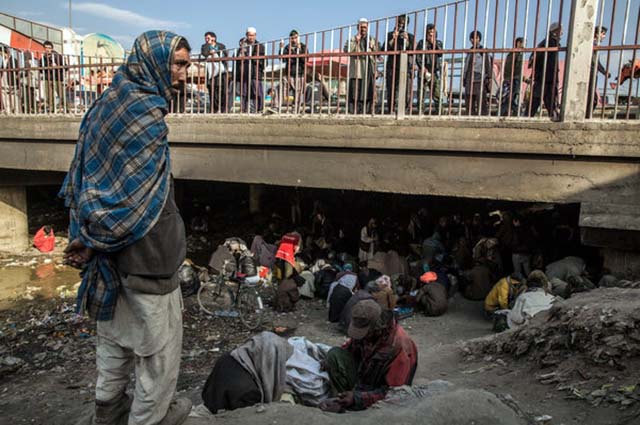In a bold move to deal with the crisis of drugs addiction among Afghan youths, authorities moved hundreds of the addicts from a western neighborhood of Kabul into a center which once was the main base of NATO troops in eastern Kabul. The Ministry of Counter Narcotics, in coordination with the Ministries of Public Health and Economy has set up parts of the former NATO camp Phoenix in east of Kabul as a center for threating and educating the addicts. The plan was recommended by the Ministry of Counter Narcotics which was approved by the president recently. The Ministry of Counter Narcotics has announced that it had transferred close to 400 addicts to the Camp Phoenix, and is planning to transfer thousands of drugs addicts to the center. The ministry plan to help the addicts be treated and receive job trainings. The program has been overwhelmingly applauded by Kabulis who worry of the impacts of the growing number of youths getting addicted to drugs.
The move is viewed as the first concrete measure by government authorities to deal with the problem and help the many young addicts wandering in Kabul city to recover from the debilitating addiction. The government’s measure for tackling the challenge in Kabul city is coming while the rate of drug users in Afghanistan is higher than ever. A study financed by the United States showed this year that there are currently more than three million drug users in Afghanistan, sharply higher from 1.6 million in 2012. According to a joint report by Afghan government agencies and the United States bureau of narcotics and law enforcement, addiction to drugs among Afghans is as high as 11 percent, meaning that one of every nine Afghans is in some way drug addicted. The sharp rise is attributed to the persistent lack of law and order in the country, failure of the anti-narcotics programs and the thriving poppy cultivation in the country in recent years.
Afghanistan is top producer of opium in the world, and more than 90 percent of the world’s heroin, which is the most addictive drug, comes from the county. According to media reports, now the Afghan young addicts are not confined to Kabul, but the number of addicts is growing in many of the northern and southern cities and towns. According a report by the New York Times, a large number of the farmers who are involved in cultivating poppy as well as their family members are turning to consuming drugs to cope with the hardships of the job they do. The growing number of addicts in big cities and towns across the country forebodes a major social crisis in the country. Afghanistan will be compelled to cope with the impacts of the creeping drug addiction among Afghan youths. It will be costly for the country in terms of social challenges, economic burdens and devastating a noticeable portion of the youths as the country’s labor force.
However, most of the efforts so far for eliminating the cultivation of poppy and production of opium have been unproductive. The United States and the Afghan government have systematically failed to capture and imprison high profile drug lords involved in the lucrative business in Afghanistan. In the past fourteen years of the anti-narcotics campaign, many high-profile drug traffickers with international reputation have been put in jails, but managed to escape prison. Even it is believed that Afghan authorities had been involved in securing release of such criminals. Over the past decade of the war in Afghanistan, the anti-narcotics campaign mission of the United States and the Afghan government has swayed as the war has always been a priority. In recent years, while the United States planned for pulling out from Afghanistan, the fight against narcotics went marginal while the Afghan government did not have the capability to effectively fight the growing threat.
The long-term insurgency in the country is seen as the most important factor for the failure of the past fourteen years of international efforts to combat narcotics in Afghanistan. After years of the collective efforts for eliminating production of opium in Afghanistan, the mission has failed. Afghanistan continues to be the top opium producer in the world, and the drugs addiction is now turning into a potential crisis at home. In the meantime, the poppy cultivation and production of opium continue to fuel the insurgency in the country as the lucrative business constitute a major revenue source of the Taliban and other militant groups. Poor governance and widespread corruption in the country has been playing a major role in failing the anti-narcotics mission of the past over a decade in the country. The ongoing insurgency and the poor governance have rendered the government unable of carrying out a decisive fight against opium production as well as combating the drug traffickers.
The government of Afghanistan needs to lead a dual fight against the phenomenon. On one hand, it needs to effectively work to curb the social impacts of the drugs problem in Afghanistan. It should to take comprehensive measures for preventing the population from turning into addictive substances. The only long-term solution is rule of law and order along with generation of employment for the people. On the other hand, the government should lead a more effective campaign for eliminating poppy corps and prevent the farmers from cultivating the plant. Unless it changes the course of its fight against poppy cultivation and drug trafficking, the government will continue to lead a failed mission and the crisis will grow larger. The national unity government needs to realize the nature of the threat to the future of the country’s economy and social order, and takes on a more serious fight against the phenomenon.

